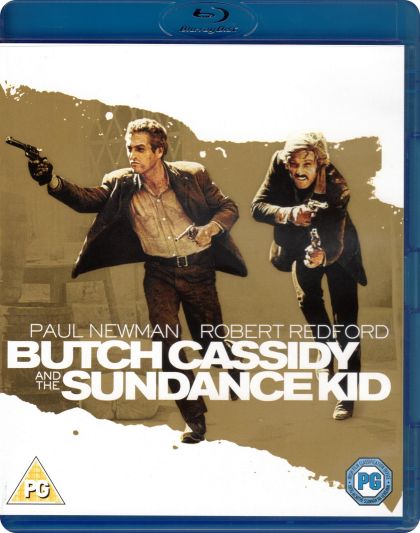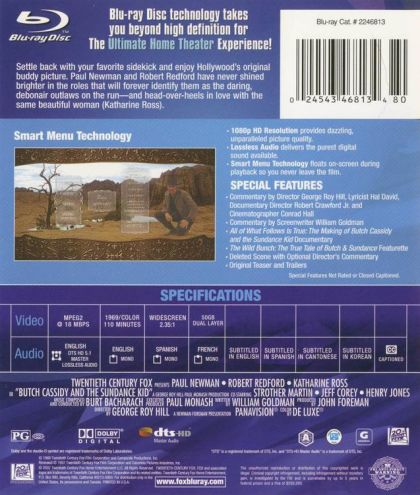Butch Cassidy And The Sundance Kid

Butch and Sundance are the two leaders of the Hole-in-the-Wall Gang. Butch is all ideas, Sundance is all action and skill. The west is becoming civilized and when Butch and Sundance rob a train once too often, a special posse begins trailing them no matter where they run. Over rock, through towns, across rivers, the group is always just behind them. When they finally escape through sheer luck, Butch has another idea, "Let's go to Bolivia". Based on the exploits of the historical characters.
—John Vogel
In the turn of the century American west, Robert LeRoy Parker and Harry Longabaugh are better known by their aliases, Butch Cassidy and the Sundance Kid, partners and arguably the most renowned outlaws in the area, they who hold up banks or trains. Within the partnership, Butch is the brains, Sundance the shooting brawn. Despite their outlaw status, they are seen as an affable duo by those that know them, even by many of their so called adversaries. Butch has compiled the Hole in the Wall Gang, named after his hideout in the Wyoming mountains, and is its de facto leader primarily because he was the one who brought them all together. But as time goes on, Butch and Sundance are finding that changing circumstances are making their work more and more difficult, which leads to others within the gang questioning Butch's leadership. Following one of the gang's jobs holding up a train, a posse of six men on horseback are after them, not the gang as a whole but rather only Butch and Sundance. The duo have to figure who the six men are to find out their end goal. In trying to get away, they are assisted by their friend, schoolteacher Etta Place who is officially Sundance's girlfriend. She ended up with Sundance instead of Butch only because the two of them saw each other first. Butch and Sundance will learn how far the posse will go to get what they were tasked to do, and in turn Butch and Sundance will also learn how far they will go to preserve their lifestyle as well as their lives.
—Huggo
The true story of fast-draws and wild rides, battles with posses, train and bank robberies, a torrid love affair and a new lease on outlaw life in far away Bolivia. It is also a character study of a remarkable friendship between Butch - possibly the most likeable outlaw in frontier history - and his closest associate, the fabled, ever-dangerous Sundance Kid.
—Jwelch5742
Two Western bank/train robbers flee to Bolivia when the law gets too close.
—Jon Reeves
SYNOPSIS
Wyoming, c. 1900s. Butch Cassidy (Paul Newman) and the Sundance Kid (Robert Redford), the leaders of the famous Hole in the Wall Gang, are planning another bank robbery. As they return to their hideout in Hole-in-the-Wall, they find out that the gang has selected a new leader, Harvey Logan. He challenges Butch to a knife fight, which Butch wins, using a ruse. Logan had the idea to rob the Union Pacific Flyer train instead of banks. He wanted to rob it twice, the idea being that the return would be considered safe and therefore more money might be involved. Butch takes this idea as his own.
The first robbery goes very well and the Marshal of the next town can't manage to raise a posse. Butch and Sundance listen to his attempts, enjoying themselves. Sundance's lover, Etta Place (Katherine Ross), is introduced. But obviously both men vie for her attention as she also goes bike-riding with Butch, a dialogue-free part of the film, accompanied by "Raindrops Keep Falling on My Head."
The second robbery goes wrong. Not only does Butch use too much dynamite to blow the safe, but also a second train arrives, which is carrying a posse of six heavily armed men on horseback that has been specially outfitted to hunt down Butch and Sundance. The gang flees, but the entire posse follows Butch and Sundance. They try hiding in a brothel in a nearby town that night, but are betrayed. When they discover that the posse is continuing to follow their trail, they try riding double on a single horse in the hope that the posse will split up, but that fails. They then arrive in a nearby town and try to arrange an amnesty with the help of a friendly sheriff (Jeff Corey) of Carbon County. But the sheriff tells them they have no chance of getting one, and that they will be hunted down until they are killed by the posse.
Still on the run the next day, they muse about the identities of their pursuers. They fixate on Lord Baltimore, a famous Indian tracker, and Joe Lefors, a tough, renowned lawman, identifiable by his white skimmer hat (which the lead posse member is wearing). After climbing some mountains, they suddenly find themselves trapped on the edge of a canyon. With their unseen pursuers on their tail, they decide to jump into the river far below, even though Sundance can't swim and would prefer to fight.
Later that day, they arrive at Etta's house and learn from the local newspapers all about the posse and the identities of their pursuers and that they have been paid to stay together until they kill Butch and the Kid. They decide that it's time to leave the country: destination Bolivia!
After a montage of showing Butch, Sundance and Etta on their travels to New York, they arrive in a small Bolivian village at the end of the world. Sundance already resents their choice. Their first attempted bank robbery fails before it gets off the ground, since they are unable to speak or understand Spanish. Etta teaches them the words they need. The following robbery is clumsily executed, as Butch still needs his crib sheet. At each succeeding robbery they appear to improve, until they are sought by the authorities all over Bolivia.
However their confidence drops one evening, as Butch, Sundance and Etta are having dinner at a fancy restaurant in a nearby town, when they see a man wearing a white straw hat standing on the other side of the street talking to a few men. Fearing that Lefors is once again after them, Butch suggests going straight, so as not to attract Lefors' attention.
They get their first honest job as payroll guards in a mine, directed by an American named Garris (Strother Martin). However, on their first working day, they are attacked by highwaymen. Garris is killed and Butch and Sundance are forced to kill the Bolivian robbers. Ironically, Butch had never killed a man in his entire criminal career, but while they are attempting to go straight, he is forced to kill the bandits. Since they seem unable to escape violence, regardless of their occupation, they decide to return to robbery. That evening, Etta decides to leave them as she senses that their days are numbered and she doesn't want to watch them die.
A few days later, Butch and Sundance attack a payroll mule train in the jungle, taking the money and the mule. When they arrive in the nearest town, San Vicente, a stable boy recognizes the brand on the mule's backside and alerts the local police. While Butch and Sundance are eating at a local eatery, the police arrive and a climactic gun battle begins.
The two of them manage to find shelter in an empty house, but they're soon low on ammunition. Butch makes a run to the mule to fetch the rest of the ammunition while Sundance covers him, shooting several Bolivian policemen. But even the "fastest gun in the West" cannot match the twenty or more Bolivian policemen at once. Butch manages to retrieve the ammunition and runs back to the house, but they are both wounded. While tending to their wounds in the house, about 100 soldiers of the Bolivian cavalry arrive and surround the place, eager to get at the notorious 'Bandidos Yanquis'.
The wounded pair discuss where they will be going next, realizing that their time is up (Butch suggests Australia, where at least they speak English). They dash out of the house in a futile attempt to get to their horses. The image freezes and slowly turns to a sepia tone tintype while a voice is heard ordering: "Fuego!" (Fire), followed by the sound of hundreds of rifles being fired in three consecutive volleys.
Cast View all
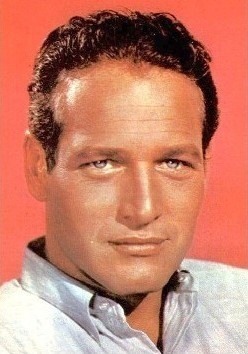
|
Paul Newman | Butch Cassidy |
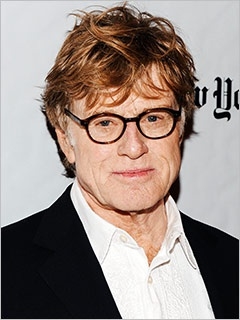
|
Robert Redford | The Sundance Kid |
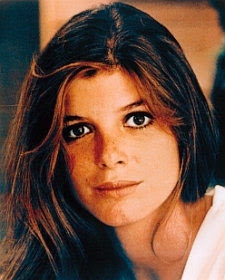
|
Katharine Ross | Etta Place |
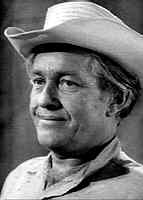
|
Strother Martin | Percy Garris |
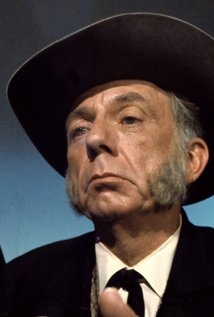
|
Henry Jones | Bike Salesman |
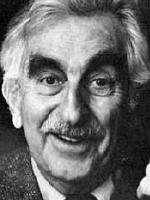
|
Jeff Corey | Sheriff Bledsoe |
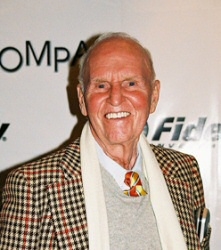
|
George Furth | Woodcock |
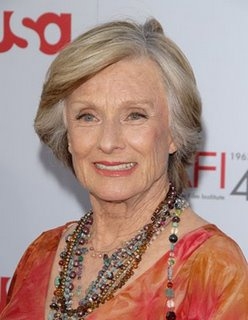
|
Cloris Leachman | Agnes |
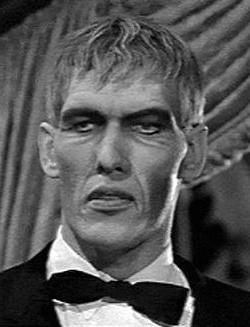
|
Ted Cassidy | Harvey Logan |
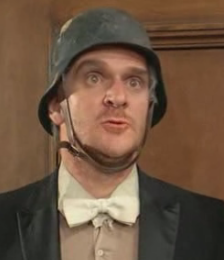
|
Kenneth Mars | Marshal |
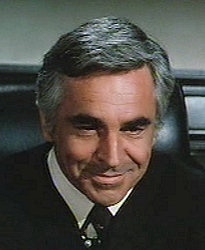
|
Donnelly Rhodes | Macon |
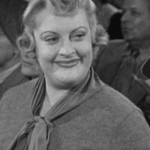
|
Jody Gilbert | Large Woman |
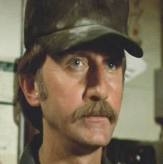
|
Timothy Scott | News Carver |
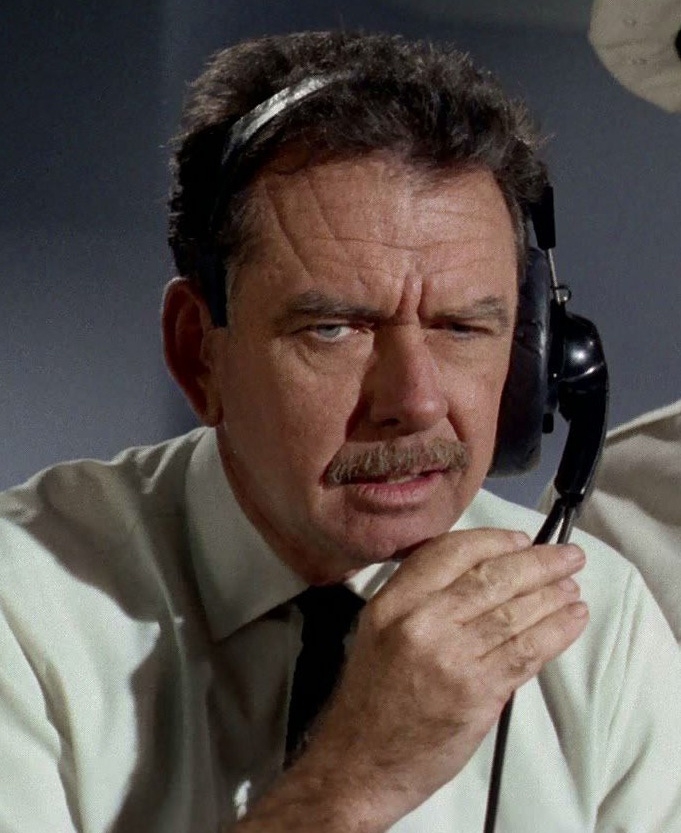
|
Don Keefer | Fireman |
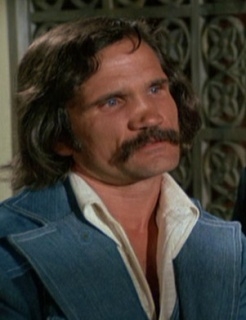
|
Charles Dierkop | Flat Nose Curry |
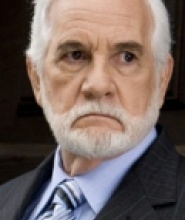
|
Pancho Córdova | Bank Manager |
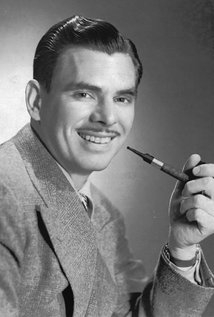
|
Nelson Olmsted | Photographer |
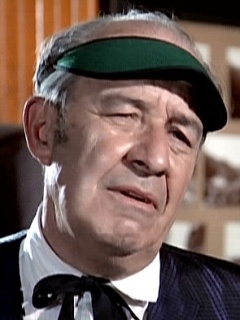
|
Paul Bryar | Card Player #1 |
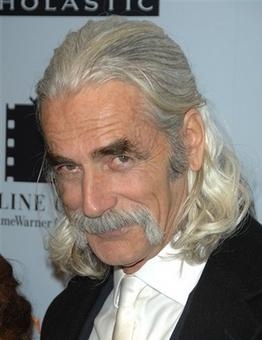
|
Sam Elliott | Card Player #2 |

|
Charles Akins | Bank Teller |

|
Eric Sinclair | Tiffany's Salesman |

|
Douglas Bank | Citizen |
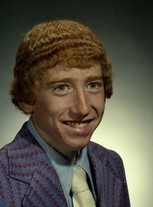
|
Larry Barton | Citizen |

|
Rico Cattani | Bank Guard |
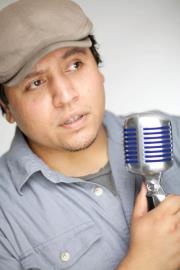
|
José Chávez | Bolivian Police Commander |
Crew
| Director | George Roy Hill |

|
| Writer | William Goldman | |
| Producer | John Foreman, Paul Monash, Paul Newman | |
| Musician | Burt Bacharach | |
| Photography | Conrad L. Hall | |
Edition details
| Edition | The Ultimate Edition DVD |
|---|---|
| Packaging | Custom Case |
| Nr Discs | 2 |
| Screen Ratios | 2.35 Anamorphic Wide Screen |
| Audio Tracks | Commentary [English] Dolby Digital Mono [English] Dolby Digital Mono [French] Dolby Digital Mono [Spanish] English Dolby Digital 2.0 Stereo |
| Subtitles | Closed Caption English | English | Spanish |
| Layers | Single side, Dual layer |
| Edition Release Date | May 16, 2000 |
| Regions | Region A |
Personal
| Owner | Kerry & Dawn |
|---|---|
| Location | Movies-04 |
| Storage Device | TD 10 |
| Purchased | On Mar 16, 2013 |
| Watched | Jul 15, 2018 |
| Quantity | 1 |
| Index | 155 |
| Added Date | May 17, 2015 05:39:17 |
| Modified Date | Apr 17, 2024 00:46:05 |
Notes
From The Guardian
New find details deadly chapter in Butch and Sundance’s escape to South America
Killing of officer in Chilean town of Antofagasta set in motion events that led to pair’s death in shootout with Bolivian soldiers
08:30 UTC Friday, 16 December 2022
The two outlaws spent their nights carousing in the bordellos of a far west mining town where they were holed up, on the run from the law. One night, one of the fugitives got into a brawl at an after-hours restaurant. Lawmen arrived and ordered everyone into the street, but the drunken bandit drew his gun. He fired a single shot; an officer died.
The 1905 scene did not play out in the US, but in the Chilean port of Antofagasta – a boom town that at the time was as wild as any in the old American west – and it was detailed in a judicial report recently rediscovered in the country’s national archives.
The protagonists were the notorious US outlaws Butch Cassidy and the Sundance Kid, and the dog-eared file has revealed a previously unreported incident in their flight to South America, later immortalised in the eponymous 1969 film.
“It’s an unknown chapter in their life,” said Anne Meadows, who discovered the file with her husband Dan Buck. The couple have spent decades trailing the pair’s escape to South America, a search that has continued even after the 1994 publication of their book Digging Up Butch and Sundance. The couple have returned to South America 15 times, visiting the outlaws’ every known hiding place in Argentina, Chile and Bolivia in search of clues.
But the newly discovered document – which Meadows and Buck found this June – proves not only that Sundance, whose real name was Harry Alonzo Longabaugh, killed a police officer in Chile but also that he was helped to escape by a US diplomat.
“It happened in this period between Argentina and Bolivia when no one really knows what they were up to,” said Meadows, speaking by telephone from their home in Washington. “Sundance had been in the bordellos of Antofagasta that evening, and several other evenings, with Butch Cassidy,” added Buck.
The wild west outlaws had escaped to Argentina in 1901 after a series of brazen train robberies in the US had put the renowned Pinkerton Detective Agency on their tail. With Sundance’s lover Etta Place, they boarded the British ship Herminius to Buenos Aires.
They settled in a small cabin in Cholila, a tiny town in southern Argentina, enjoying an idyllic existence until mid-1905, when the Argentinian police were alerted by Pinkerton and began to hunt them down. Sundance accompanied his wife in a ship back to the US, then returned alone to join Cassidy, who had gone into hiding in Chile. In Argentina, he had called himself Harry Place, but once he crossed the border, he went back to the pseudonym he had once used in the US: Frank Boyd.
Sundance’s rash act in Antofagasta set in motion the series of events that led, three years later, to their death in a shootout with a Bolivian army unit, fictionalised in the film’s famous last scene in which Paul Newman and Robert Redford are freeze-framed as they charge, guns blazing, into a hail of gunfire.
The Chilean document relates the events of 21 August 1905 in microscopic detail. “Depending on whose version you believe, Sundance either shot his gun or it went off accidentally,” said Buck. “Butch Cassidy didn’t find out about it till later in the morning,” added Meadows.
Cassidy enlisted Frank Aller, the US vice-consul in Antofagasta, who signed a bond, equivalent to $50,000 today, for the release of Frank Boyd. “Aller even provided a house for Sundance’s house arrest,” said Meadows.
The killing was reported in the pages of the Antofagasta daily El Industrial. “A decently dressed man, of Yankee nationality, who in his manners and in everything purported to be a gentleman of good standing” shot the officer at close range, “killing him instantly,” the newspaper reported.
Sundance was arrested at his hotel trying to hire a carriage to leave the city. He had nearly $70,000 in cash, a firearm and munitions, as described in an article by Meadows and Buck published in this month’s journal of the Wild West History Association.
The 24-year-old officer, Arturo González, was buried the next day with full honours, including a procession, marching band and a flower-draped hearse followed by his young widow and two-year-old son.
Boyd’s shot was “fixed and calculated … he must be well versed in handling a revolver,” said witnesses. Boyd alleged that “the shot was fired by chance, which happens so many times and very easily with the Smith & Wesson revolver without an open trigger, which I carried”.
Butch testified in Sundance’s favour under the alias Thomas Fisher. “I am Frank Boyd’s partner, and we have come from the United States to study the cattle business,” he said.
Sundance was eventually released into the care of the US vice-consul. Predictably, Sundance fled, leaving Aller responsible for paying the $50,000 bond. It is not clear if he ever did. “We think Cassidy may have advanced Aller the money,” said Meadows.
The pair headed back to Argentina, got in trouble again for a bank heist there, and then fled north to Bolivia, where they faced their last stand in November 1908.
Meadows and Buck had given up on ever finding the missing pieces of the puzzle. But unbeknown to them, copies of the old El Industrial newspaper had been digitised in Chile.
A fluke online search by Buck turned up a host of articles about the Frank Boyd case, which led the couple to the revealing judicial file. “It arrived out of nowhere, and serendipitously,” said Buck.
The film that created a legend … and became a legend
In 1969, Butch Cassidy and the Sundance Kid made Hollywood history – and remade American history. This sublimely seductive western thriller took the already stellar careers of Paul Newman and Robert Redford to new levels; their impossible handsomeness and cool wit made them almost godlike.
The film also took the then little-known 19th-century bank robbers Robert Leroy Parker (aka Butch Cassidy) and Harry Longbaugh (aka the Sundance Kid) of the murderous Wild Bunch and reshaped their lives, reinventing them as groovy countercultural outlaws, not so different from Dennis Hopper and Peter Fonda in Easy Rider. And imagining these guys’ escape to South America in the company of Sundance’s girlfriend, played by Katharine Ross, made them jazzily bohemian and à trois in the French style, like Truffaut’s Jules Et Jim or Godard’s Bande à Part – although the sexist treatment of Ross’s character jars a bit now.
Newman’s goofy clowning around on a bike to the tune of Burt Bacharach’s Raindrops Keep Falling on My Head is tremendous, although with anyone less charismatic it would just be cloying. And Redford’s laconic delivery is a joy: “Think you used enough dynamite there, Butch?” says Sundance when the entire train carriage explodes.
Basically, Butch and Sundance invented the “buddy comedy” in Hollywood cinema which morphed into the bromance of recent times. And the Sundance Kid, that tough American icon, in effect lent his stonewashed American authenticity and ruggedness to the films that keep coming out of Redford’s Sundance film festival.
The film created a legend, and it’s a legend itself.
-- Peter Bradshaw


 English
English  Nederlands
Nederlands  Deutsch
Deutsch  Français
Français  Español
Español  Magyar
Magyar  српски
српски  Dansk
Dansk  Italiano
Italiano  Svenska
Svenska  Slovenčina
Slovenčina  Português
Português 
